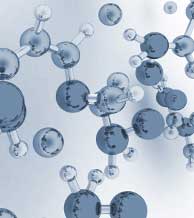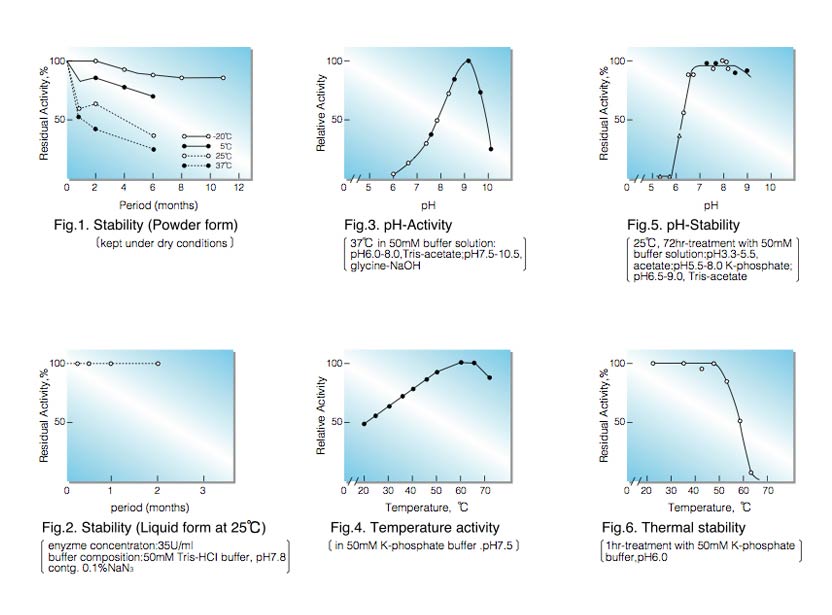PROTOCATECHUATE 3,4-DIOXYGENASE from Pseudomonas sp.
Protocatechuate:oxygen 3,4-oxidoreductase (decyclizing) (EC 1.13.11.3)
Protocatechuate + O₂ ► ß-Carboxymuconate
| Appearance: | Light brown amorphous powder, lyophilized |
|---|---|
| Activity: | GradeⅢ 3.0U/mg-solid or more (containing approx. 40% of stabilizers) |
| Contaminant: | NADPH oxidase ≤1.0×10⁻¹% |
| Stabilizers: | Sugars |
| Stability: | Store at -20°C (A decrease in activity of ca. 20% may occur within one year) (Fig.1) |
|---|---|
| Molecular weight : | approx. 700,000 |
| Michaelis constant: | 1.85×10⁻⁵M (Protocatechuate) |
| Structure: | Protein with nonheme iron |
| Inhibitors: | Ag⁺, Hg⁺⁺, PCMB |
| Optimum pH : | 9.0(Fig.3) |
| Optimum temperature : | 60-65°C(Fig.4) |
| pH Stability : | pH 7.0-9.0 (25°C, 72hr)(Fig.5) |
| Thermal stability : | below 50°C (pH 6.0, 1hr)(Fig.6) |
| Effect of various chemicals : | (Table 1) |
APPLICATIONS
This enzyme is useful for enzymatic determination of choline esterase when coupled with p- hydroxybenzoate hydroxylase.
PCO-301
ASSAY
Principle:
protocatechuate 3,4-dioxygenase
Protocatechuate+O₂ ► ß-Carboxymuconate
The disappearance of protocatechuate is measured at 290nm by spectrophotometry.
Unit definition:
One unit causes the oxidation of one micromole of protocatechuate per minute under the conditions described below.
Method:
| A. Tris-acetate buffer, pH 7.5: | 50mM[Dissolve 6.1g of Tris (MW=121.14) in ca.800ml of H₂O and, after adjusting pH to 7.5 at 25°C with 0.2M acetic acid, fill up to 1,000ml with H₂O.] |
|---|---|
| B. Protocatechuate acid solution: | 0.4mM[Dissolve 6.16mg of protocatechuate in ca.80ml of buffer (A) and, after adjusting pH to 7.5 at 25°C with 1.0N KOH, fill up to 100ml with buffer (A).] (Should be prepared fresh) |
Procedure
| Concentration in assay mixture | |
|---|---|
| Tris-acetate buffer | 50 mM |
| Protocatechuate | 0.39 mM |
1. Pipette 3.0ml of protocatechuate solution (B) into a cuvette (d=1.0cm) and equilibrate at 37°C for about 5 minutes.
2. Add 0.05ml of the enzyme solution* and mix by gentle inversion.
3. Record the decrease in optical density at 290nm against water for 3 to 4 minutes in a spectrophotometer thermostated at 37°C, and calculate the ΔOD per minute from the initial linear portion of the curve (ΔOD test).
At the same time, measure the blank rate (ΔOD blank) by using the same method as the test except that the enzyme diluent (A) is added instead of the enzyme solution.
* Dissolve the enzyme preparation in ice-cold diluent (A) (1.0mg/ml or more) and dilute to 0.2-0.8U/ml with the same buffer, immediately before assay.
Calculation
Activity can be calculated by using the following formula :

ΔOD/min (ΔOD test-ΔOD blank)×Vt×df
Volume activity (U/ml) = = ΔOD/min×16.1×df
3.8×1.0×Vs
Weight activity (U/mg)=(U/ml)×1/C
- Vt
- : Total volume (3.05ml)
- Vs
- : Sample volume (0.05ml)
- 3.8
- : Millimolar extinction coefficient of protocatechuate (㎠/micromole)
- 1.0
- : Light path length (cm)
- df
- : Dilution factor
- C
- : Enzyme concentration in dissolution (c mg/ml)
REFERENCES
- H.Fujisawa and O.Hayashi; J.Biol.Chem., 243, 2673 (1968)
| Chemical | Concn.(mM) | Residual activity |
Chemical | Concn.(mM) | Residual activity |
|---|---|---|---|---|---|
| None | − | 100% | PCMB | 1.0 | 0 |
| Metal salt | 1.0 | NaF | 1.0 | 98 | |
| ZnCl₂ |
91 | NaN₃ | 1.0 | 79 | |
| CuSO₄ | 90 | EDTA | 5.0 | 100 | |
| AgNO₃ | 0 | Borate | 50 | 90 | |
| MgSO₄ | 95 | Tween 20 | 0.1% | 95 | |
| BaCl₂ | 100 | Brij 35 | 0.1% | 112 | |
| MnCl₂ | 107 | SDS | 0.05% | 85 | |
| NiCl₂ | 98 | Na-cholate | 0.1% | 93 | |
| CaCl₂ | 109 |
||||
| HgCl₂ | 3.4 | ||||
| CrCl₂ | 100 |
||||
| CdCl₂ | 100 |
||||
| CoCl₂ | 95 | ||||
| FeSO₄ | 88 |
PCMB, p-Chloromercuribenzoate; EDTA, Ethylenediaminetetraacetate; SDS, Sodium dodecyl sulfate

To get a quote, contact us at info@toyobousa.com, or INQUIRY.